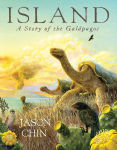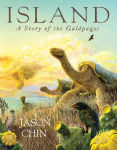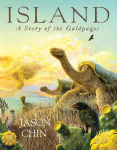Handsome and succinct...” —The Wall Street Journal
“Chin's remarkable introduction to the Galápagos is not just a story. It's a biography. It begins with an island's "birth" six million years ago. "A volcano has been growing under the ocean for millions of years," Chin writes. "With this eruption it rises above the water for the first time, and a new island is born." In full-page watercolor paintings and small-size panel illustrations, Chin shows how the tremendous explosion leaves a mass of lava, which hardens and grows into an island. Any reader who has ever made a homemade "volcano" out of baking soda will be hooked. Writing scientific narrative nonfiction for young children is challenge enough, but creating engaging picture books for older children about the natural world isn't easy either. How to pull in the "Diary of a Wimpy Kid" reader? Credit to Jason Chin, who succeeded at both in "Coral Reefs" (2011) and "Redwoods" (2009). He does so again in his latest, "Island: A Story of the Galápagos." Chin, as author-illustrator, melds geology with evolution, showing how the land and its inhabitants interact and shape one another in a natural-world interplay. We see how a few intrepid immigrant animals arrive, colonize and transform themselves to accommodate the particular features of their new home. The island grows and changes too as new eruptions lead to the appearance of other nearby islands, while eruptions on the original island grow infrequent, and then cease. ...a remarkable work and an asset for educators...” —Publishers Weekly, starred
“Chin's gorgeous illustrations include sweeping double-page spreads of the island and its inhabitants…” —Horn Book Magazine, starred
“Another superb contribution to scientific literature by Chin.” —Kirkus, starred
“...this fine introduction to [the Galápagos] will surely stimulate readers' interest.” —School Library Journal, starred
“The art is masterful in its combination of realism and artistic flow; the layout complements sweeping full-page, full-bleed landscapes with carefully controlled panel sequences that provide additional focus on a process or creature, so the evolution of larger finches' beaks, for instance, is clearly demonstrated and explained.” —BCCB, starred review
A beautifully made picture book presents the story of the Galápagos Islands for young readers. It's not easy to present the story of island formation, species colonization and evolution in a picture book, but Chin succeeds admirably, challenging intelligent young readers with sophisticated concepts, but presenting them in a way that will allow readers not only to understand them, but to marvel at them, as well. As in Chin's previous volumes, Redwoods (2009) and Coral Reefs (2011), gorgeous watercolor illustrations lure readers into the scientific story. Chin is careful to point out in his author's note the necessity of speculation and educated guesses, given how far in the past the story takes place. But the work is top-notch narrative nonfiction, based on the best current scientific research. An eye-catching variety of horizontal panels, thumbnails and full-bleed pages makes science visual. Especially effective is the discussion of how species change over time: The finches' beaks become larger, tortoises' shells change shape, and cormorants' wings shrink. In the epilogue, after millions of years of evolution, a ship appears, and a man comes ashore, pen and notebook in hand. It's Charles Darwin, as explained in the backmatter, where his theory of evolution by natural selection is explained and further information on the Galápagos Islands and their indigenous species is presented. Another superb contribution to scientific literature by Chin. (Informational picture book. 8-12)








